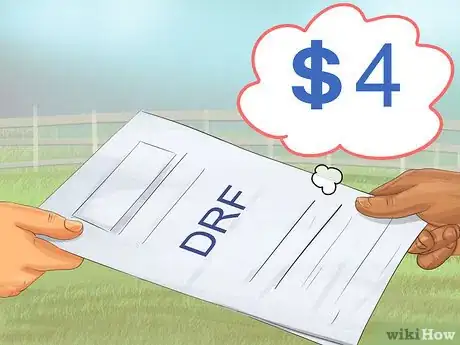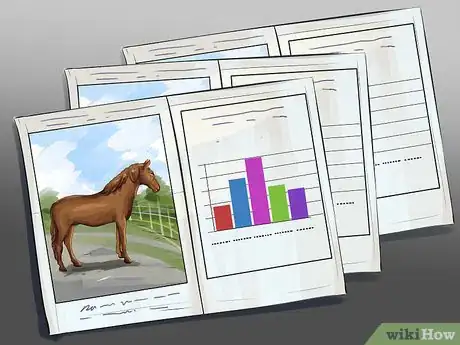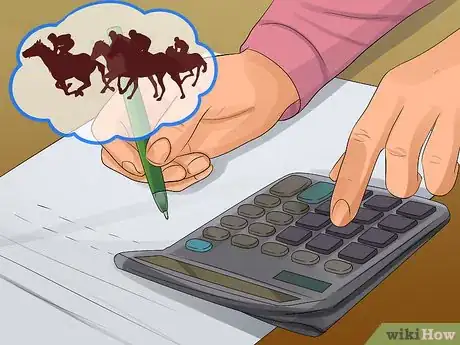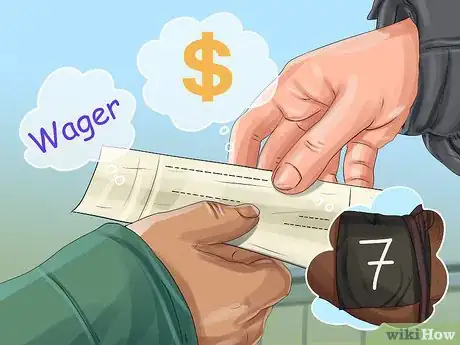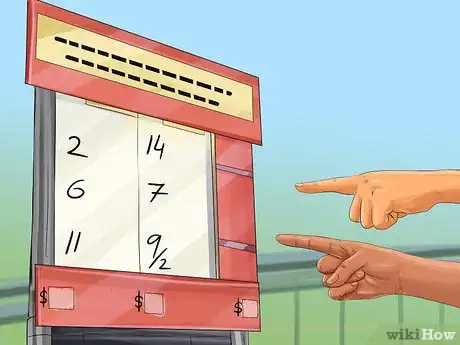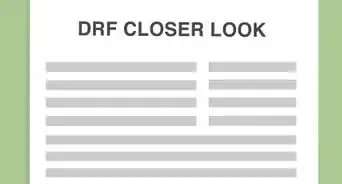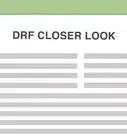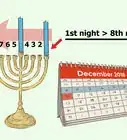This article was co-authored by wikiHow Staff. Our trained team of editors and researchers validate articles for accuracy and comprehensiveness. wikiHow's Content Management Team carefully monitors the work from our editorial staff to ensure that each article is backed by trusted research and meets our high quality standards.
wikiHow marks an article as reader-approved once it receives enough positive feedback. In this case, 91% of readers who voted found the article helpful, earning it our reader-approved status.
This article has been viewed 137,248 times.
Learn more...
Betting on a live horse race can be fun, exciting, and profitable. Increase your odds of winning by looking at stats and race records. Decide whether you want to place safe bets or take a higher risk to yield more if you win. Learning the horse betting rules can be quite confusing at first, but after some experience you will be betting like a pro!
Steps
Getting Betting Information
-
1Purchase a program for information on horses and jockeys. Buy a racetrack program from the betting counter. Read the program for information on all for the horses racing as well as their jockeys, trainers, and owners. The program usually costs around $3 USD, depending on the racetrack you visit.[1]
- Racetrack programs offer general information and can be used whenever you visit the track.
- Read through the program to acquaint yourself with the horses and jockeys, who are responsible for bringing out their horse's full potential.
-
2Buy a Daily Racing Form to read about past performances. Daily Racing Forms (DRFs) are produced by the racetrack to offer more information about the day's contestants. Purchase a DRF at the betting counter, which will provide you with records of past performances as well as handicapping. DRFs normally cost about $4 USD.[2]
- Daily racing forms also include detailed articles about horse racing.
- DRFs are produced daily, and are written specifically about the day's contestants.
Advertisement -
3Check a local newspaper for handicapper selections. Some newspapers cover events at the local racetrack. Check a local newspaper for handicappers' selections, which are sometimes published. Professional handicappers analyze the odds of a race to produce predictions about the outcome.[3]
- Alternatively, racetracks often sell handicapping tips sheets for about $2 USD.
Choosing a Horse
-
1Look at the horse's odds of winning. Look at the estimated odds of each horse winning the race. This will appear as a large number printed next to the horse's stats. Check out the horses' race records for a better indication of their winning ability.[4]
- For instance, good odds for a horse might be 3-1 while long odds could be closer to 15-1. That means that the first horse has a 25% chance of winning, while the other horse only has a 6.25% chance.
- If you bet $2 USD on a horse with 3-1 odds, you will win $8 USD. If you bet the same amount of a horse with 15-1 odds, you will win $32 USD.
-
2View the jockey's stats and odds. In addition to each horse's unique stats, factor in the history and odds of the jockey who will be riding them. The racetrack program and Daily Racing Form will indicate these numbers. The jockey's overall win percentage should be printed in the back of your program.[5]
-
3Check the racetrack monitors for last minute updates about races. In addition to odds, selections, and race records, consider variable factors that might change the results of a race. The published odds are estimates and can change depending on things like the condition of the track and the current state of health of the horses. Check the monitors in the racetrack prior to each race for these updates.
-
4Keep tabs on racehorses' records throughout the year. Track the wins and losses of different racehorses at the track during the year so that you're well-informed on any given race day. Read a newspaper that covers the results of local races to stay in the loop. Alternatively, visit the track from time to time without betting to see how the horses are performing.[6]
-
5Look up racehorse pedigree information. A horse's genetic background may suggest that they've inherited a winning characteristic, such as speed. Look up handicapping charts and pedigree information online to see if a racehorse is descended from other winning horses. A strong pedigree is a telling indicator of a horse's performance.[7]
Placing a Wager
-
1Set a betting budget. To ensure that you don't lose a large amount of money while betting on a horse race, decide in advance how much you are willing to spend. Think about what type of bets you would like to place and how much risk you are willing to take. Note that the minimum bet is $2 USD for the most basic wager.[8]
-
2Place your bet at the betting window if you are at a racetrack. Go to the betting window and tell the clerk the number of the race you're betting on. Tell them how much you are betting, the type of wager, and the number of the horse as it is listed in the program. Be sure to check your betting ticket before leaving the window to correct any mistakes that might be on it.
- Automatic tellers are also available at some racetracks.
-
3Place a bet online if you want to bet from home. Horse betting can be done online through sites that use advance deposit wagering. Read the rules and regulations of a site and register to be able to place a bet. Look for a site that offers free video streaming of the horse races, and doesn't demand a sign-up fee or wagering fees for each bet.[9]
-
4Make a straight “win” wager. A straight win wager is the simplest bet to place at the racetrack. Choose 1 horse and bet on it winning first place. The odds of winning a “win” wager are average.[10]
-
5Bet on your horse “placing” or “showing.” Place a bet on your horse “placing” (i.e., either winning or coming in second), which will increase your odds of winning. The payout will be less, but the risk of losing is also smaller. To make the bet even safer, bet on your horse “showing,” which means you will get a payout if it comes in first, second, or third.[11]
-
6Place an “across the board” bet. If you're feeling confident, place an “across the board” bet, which is essentially 3 bets in 1. It is usually 3 times more expensive than “win,” “place,” or “show” bets because you're betting on your horse winning all the first 3 places. If your horse wins, you get the money from all 3 bets.[12]
-
7Make an exotic wager. Unlike “straight” wagers, “exotic” wagers involve multiple horses and very specific situations. These bets are often 3 or 4 times more expensive than simple bets and have lower odds, but hold the potential for a larger payout if you win. Choose your bet carefully and only go through with it if you have enough cash to handle a likely loss. Some examples of “exotic” bets are:[13]
- A “quinella” bet, where your horses must finish first and second, in any order. This is the simplest “exotic” bet to place.
- An “exacta” bet, where your horses must finish first and second in the specific order you choose.
- A “trifecta” bet, where your horses must win first, second, and third place in the specific order you choose.
- A “daily double” bet, where your horses must win two consecutive races on the same day. This varies in risk given the number of horses you bet on.
- A “pick 3” race, where your horses must win three consecutive races on the same day. This is essentially a “daily double” plus another race.
Community Q&A
-
QuestionCan I make a $5 bet?
 Community AnswerIt depends on where you go, every facility will have its own minimum betting requirement.
Community AnswerIt depends on where you go, every facility will have its own minimum betting requirement. -
QuestionCan I win $100 billion?
 Community AnswerYes, it is possible but very unlikely.
Community AnswerYes, it is possible but very unlikely. -
QuestionWhat if I didn't cash in my tickets - how can I find out if they are good or not?
 Community AnswerUsually tickets expire after 12 months. Credits don't expire. You can look up race results online, or go back to track to find out and/or cash them in.
Community AnswerUsually tickets expire after 12 months. Credits don't expire. You can look up race results online, or go back to track to find out and/or cash them in.
Warnings
- Gambling can sometimes become an addiction and negatively affect your life. If necessary, seek help in dealing with this addiction.⧼thumbs_response⧽
References
- ↑ http://www.dummies.com/games/casino-games/betting-on-horse-racing-for-dummies-cheat-sheet/
- ↑ http://www.dummies.com/games/casino-games/betting-on-horse-racing-for-dummies-cheat-sheet/
- ↑ http://www.dummies.com/games/casino-games/betting-on-horse-racing-for-dummies-cheat-sheet/
- ↑ http://www.artofmanliness.com/2012/05/03/how-to-bet-on-horses/
- ↑ http://www.dummies.com/games/casino-games/betting-on-horse-racing-for-dummies-cheat-sheet/
- ↑ https://www.sbnation.com/2017/5/5/15556364/horse-racing-betting-gambling-picks-preakness-stakes
- ↑ http://www.drf.com/news/pedigree-stats-suggest-tapwrit-has-stamina-edge-derby
- ↑ http://www.artofmanliness.com/2012/05/03/how-to-bet-on-horses/
- ↑ https://www.sbnation.com/2017/5/5/15556364/horse-racing-betting-gambling-picks-preakness-stakes
- ↑ http://www.dummies.com/games/casino-games/betting-on-horse-racing-for-dummies-cheat-sheet/
- ↑ http://www.artofmanliness.com/2012/05/03/how-to-bet-on-horses/
- ↑ http://www.artofmanliness.com/2012/05/03/how-to-bet-on-horses/
- ↑ http://www.dummies.com/games/casino-games/betting-on-horse-racing-for-dummies-cheat-sheet/
About This Article
Before you bet on a live horse race, purchase a program to learn more about the horses racing as well as their jockeys, trainers, and owners. In addition to a program, buy a daily racing form to read about the contestants’ past performances. You’ll also want to look at the horses’ estimated odds of winning, which will be printed next to the stats. Decide if you want to put your money on a horse with good odds, like 3 to 1, or a horse that’s a long shot, like 15 to 1. While the long shot will make you more money, the odds of it winning are significantly less. When you’re ready to place your bet, go to the betting window or an online site. If you’re a beginner, make a straight “win” wager, which means if your chosen horse wins, you do too. To learn how to make an across the board bet, keep reading!

